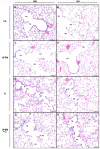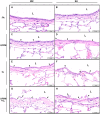Ultrafine Particulate Matter Combined With Ozone Exacerbates Lung Injury in Mature Adult Rats With Cardiovascular Disease
- PMID: 29394414
- PMCID: PMC5920298
- DOI: 10.1093/toxsci/kfy018
Ultrafine Particulate Matter Combined With Ozone Exacerbates Lung Injury in Mature Adult Rats With Cardiovascular Disease
Abstract
Particulate matter (PM) and ozone (O3) are dominant air pollutants that contribute to development and exacerbation of multiple cardiopulmonary diseases. Mature adults with cardiovascular disease (CVD) are particularly susceptible to air pollution-related cardiopulmonary morbidities and mortalities. The aim was to investigate the biologic potency of ultrafine particulate matter (UFPM) combined with O3 in the lungs of mature adult normotensive and spontaneously hypertensive (SH) Wistar-Kyoto rats. Conscious, mature adult male normal Wistar-Kyoto (NW) and SH rats were exposed to one of the following atmospheres: filtered air (FA); UFPM (∼ 250 μg/m3); O3 (1.0 ppm); or UFPM + O3 (∼ 250 μg/m3 + 1.0 ppm) combined for 6 h, followed by an 8 h FA recovery period. Lung sections were evaluated for lesions in the large airways, terminal bronchiolar/alveolar duct regions, alveolar parenchyma, and vasculature. NW and SH rats were similarly affected by the combined-pollutant exposure, displaying severe injury in both large and small airways. SH rats were particularly susceptible to O3 exposure, exhibiting increased injury scores in terminal bronchioles and epithelial degeneration in large airways. UFPM-exposure groups had minimal histologic changes. The chemical composition of UFPM was altered by the addition of O3, indicating that ozonolysis promoted compound degradation. O3 increased the biologic potency of UFPM, resulting in greater lung injury following exposure. Pathologic manifestations of CVD may confer susceptibility to air pollution by impairing normal lung defenses and responses to exposure.
Figures



Similar articles
-
Cardiac effects of seasonal ambient particulate matter and ozone co-exposure in rats.Part Fibre Toxicol. 2015 May 6;12:12. doi: 10.1186/s12989-015-0087-3. Part Fibre Toxicol. 2015. PMID: 25944145 Free PMC article.
-
The spontaneously hypertensive rat as a model of human cardiovascular disease: evidence of exacerbated cardiopulmonary injury and oxidative stress from inhaled emission particulate matter.Toxicol Appl Pharmacol. 2000 May 1;164(3):250-63. doi: 10.1006/taap.2000.8899. Toxicol Appl Pharmacol. 2000. PMID: 10799335
-
Clinical and pathological manifestations of cardiovascular disease in rat models: the influence of acute ozone exposure.Inhal Toxicol. 2015;27 Suppl 1:26-38. doi: 10.3109/08958378.2014.954168. Inhal Toxicol. 2015. PMID: 26667329
-
Ozone-induced lung injury and inflammation: Pathways and therapeutic targets for pulmonary diseases caused by air pollutants.Environ Int. 2025 Apr;198:109391. doi: 10.1016/j.envint.2025.109391. Epub 2025 Mar 20. Environ Int. 2025. PMID: 40121788 Review.
-
Pharmacotherapeutic Strategies for Fine Particulate Matter-Induced Lung and Cardiovascular Damage: Marketed Drugs, Traditional Chinese Medicine, and Biological Agents.Cardiovasc Toxicol. 2025 May;25(5):666-691. doi: 10.1007/s12012-025-09985-3. Epub 2025 Mar 20. Cardiovasc Toxicol. 2025. PMID: 40113640 Review.
Cited by
-
Associations of ambient PM2.5 and O3 with cardiovascular mortality: a time-series study in Hefei, China.Int J Biometeorol. 2019 Oct;63(10):1437-1447. doi: 10.1007/s00484-019-01766-2. Epub 2019 Aug 5. Int J Biometeorol. 2019. PMID: 31385092
-
Transcriptomics of single dose and repeated carbon black and ozone inhalation co-exposure highlight progressive pulmonary mitochondrial dysfunction.Part Fibre Toxicol. 2021 Dec 15;18(1):44. doi: 10.1186/s12989-021-00437-8. Part Fibre Toxicol. 2021. PMID: 34911549 Free PMC article.
-
The bio-distribution, clearance pathways, and toxicity mechanisms of ambient ultrafine particles.Eco Environ Health. 2023 Jun 10;2(3):95-106. doi: 10.1016/j.eehl.2023.06.001. eCollection 2023 Sep. Eco Environ Health. 2023. PMID: 38074989 Free PMC article. Review.
-
Aerosol physicochemical determinants of carbon black and ozone inhalation co-exposure induced pulmonary toxicity.Toxicol Sci. 2023 Jan 31;191(1):61-78. doi: 10.1093/toxsci/kfac113. Toxicol Sci. 2023. PMID: 36303316 Free PMC article.
-
The pro-inflammatory effects of combined exposure to diesel exhaust particles and mineral particles in human bronchial epithelial cells.Part Fibre Toxicol. 2022 Feb 21;19(1):14. doi: 10.1186/s12989-022-00455-0. Part Fibre Toxicol. 2022. PMID: 35189914 Free PMC article.
References
-
- Anjilvel S., Asgharian B. (1995). A multiple-path model of particle deposition in the rat lung. Fundam. Appl. Toxicol. 28, 41–50.http://dx.doi.org/10.1006/faat.1995.1144 - DOI - PubMed
-
- Bentayeb M., Simoni M., Baiz N., Norback D., Baldacci S., Maio S., Viegi G., Annesi-Maesano I. and Geriatric Study in Europe on Health Effects of Air Quality in Nursing Homes Group. (2012). Adverse respiratory effects of outdoor air pollution in the elderly. Int. J. Tuberc. Lung Dis. 16, 1149–1161. - PubMed
-
- Bernatek E. (1958). Ozonolysis of napthoquinones. Tetrahedron 4, 213–222.http://dx.doi.org/10.1016/0040-4020(58)80043-5 - DOI
Publication types
MeSH terms
Substances
Grants and funding
LinkOut - more resources
Full Text Sources
Other Literature Sources
Medical

